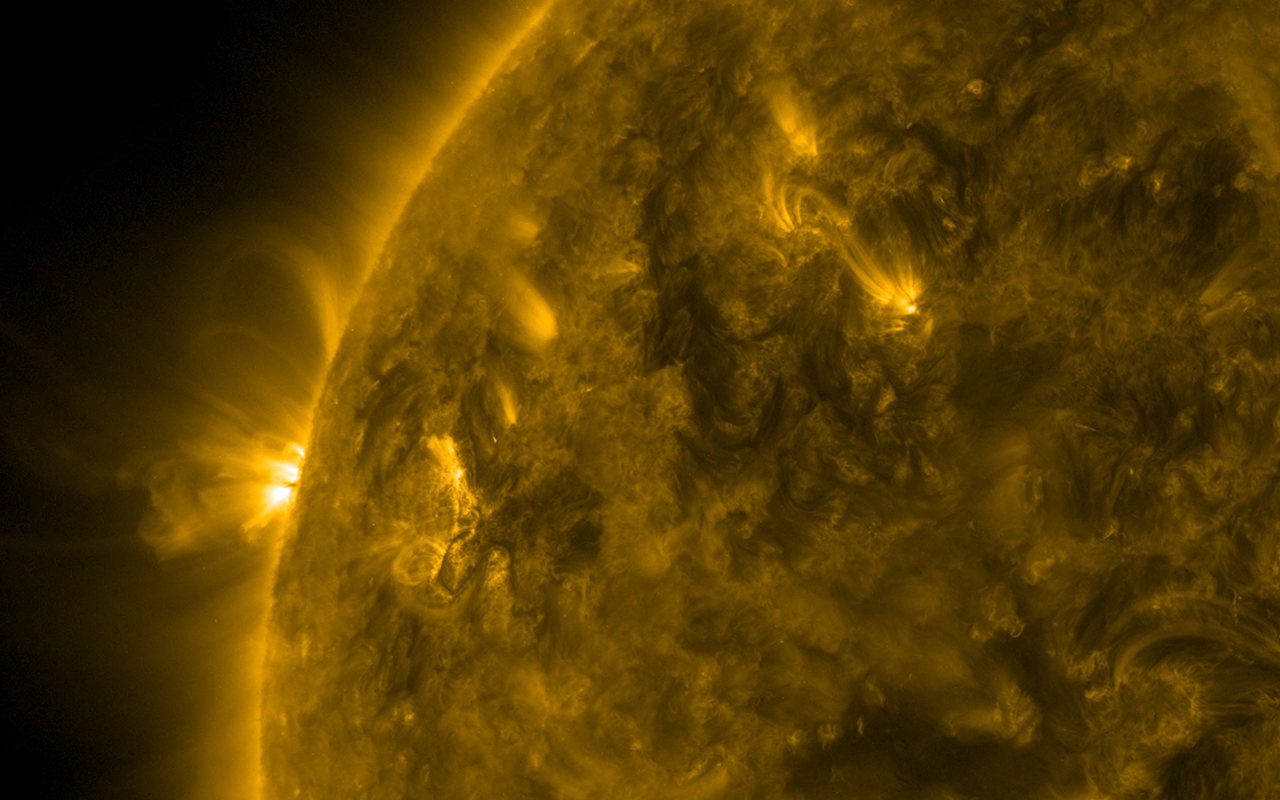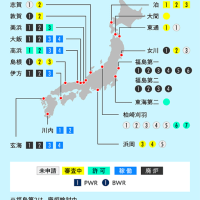2018-02-19 05:11:51 SpaceCom
It's cold, isn't it?
Reduced Energy from the Sun Might Occur by Mid-Century. Now Scientists Know by How Much.
UC San Diego scientists review satellite observations of nearby Sun-like stars to estimate the strength of the next “grand minimum” period of diminished UV radiation

Magnetic loops gyrate above the sun, March 23-24, 2017. Photo: NASA/GSFC/Solar Dynamics Observatory
The Sun might emit less radiation by mid-century, giving planet Earth a chance to warm a bit more slowly but not halt the trend of human-induced climate change.
The cooldown would be the result of what scientists call a grand minimum, a periodic event during which the Sun’s magnetism diminishes, sunspots form infrequently, and less ultraviolet radiation makes it to the surface of the planet. Scientists believe that the event is triggered at irregular intervals by random fluctuations related to the Sun’s magnetic field.
Scientists have used reconstructions based on geological and historical data to attribute a cold period in Europe in the mid-17th Century to such an event, named the “Maunder Minimum.” Temperatures were low enough to freeze the Thames River on a regular basis and freeze the Baltic Sea to such an extent that a Swedish army was able to invade Denmark in 1658 on foot by marching across the sea ice.
A team of scientists led by research physicist Dan Lubin at Scripps Institution of Oceanography at the University of California San Diego has created for the first time an estimate of how much dimmer the Sun should be when the next minimum takes place.
There is a well-known 11-year cycle in which the Sun’s ultraviolet radiation peaks and declines as a result of sunspot activity. During a grand minimum, Lubin estimates that ultraviolet radiation diminishes an additional seven percent beyond the lowest point of that cycle. His team’s study, “Ultraviolet Flux Decrease Under a Grand Minimum from IUE Short-wavelength Observation of Solar Analogs,” appears in the publication Astrophysical Journal Letters and was funded by the state of California.
“Now we have a benchmark from which we can perform better climate model simulations,” Lubin said. “We can therefore have a better idea of how changes in solar UV radiation affect climate change.”
Lubin and colleagues David Tytler and Carl Melis of UC San Diego’s Center for Astrophysics and Space Sciences arrived at their estimate of a grand minimum’s intensity by reviewing nearly 20 years of data gathered by the International Ultraviolet Explorer satellite mission. They compared radiation from stars that are analogous to the Sun and identified those that were experiencing minima.
The reduced energy from the Sun sets into motion a sequence of events on Earth beginning with a thinning of the stratospheric ozone layer. That thinning in turn changes the temperature structure of the stratosphere, which then changes the dynamics of the lower atmosphere, especially wind and weather patterns. The cooling is not uniform. While areas of Europe chilled during the Maunder Minimum, other areas such as Alaska and southern Greenland warmed correspondingly.
Lubin and other scientists predict a significant probability of a near-future grand minimum because the downward sunspot pattern in recent solar cycles resembles the run-ups to past grand minimum events.
Despite how much the Maunder Minimum might have affected Earth the last time, Lubin said that an upcoming event would not stop the current trend of planetary warming but might slow it somewhat. The cooling effect of a grand minimum is only a fraction of the warming effect caused by the increasing concentration of carbon dioxide in the atmosphere. After hundreds of thousands of years of CO2 levels never exceeding 300 parts per million in air, the concentration of the greenhouse gas is now over 400 parts per million, continuing a rise that began with the Industrial Revolution. Other researchers have used computer models to estimate what an event similar to a Maunder Minimum, if it were to occur in coming decades, might mean for our current climate, which is now rapidly warming.
One such study looked at the climate consequences of a future Maunder Minimum-type grand solar minimum, assuming a total solar irradiance reduced by 0.25 percent over a 50-year period from 2020 to 2070. The study found that after the initial decrease of solar radiation in 2020, globally averaged surface air temperature cooled by up to several tenths of a degree Celsius. By the end of the simulated grand solar minimum, however, the warming in the model with the simulated Maunder Minimum had nearly caught up to the reference simulation. Thus, a main conclusion of the study is that "a future grand solar minimum could slow down but not stop global warming."
太陽の活動減退で「ミニ氷河期」が2020年から2050年にかけて到来する可能性
It's cold, isn't it?

By Broo_am (Andy B)
太陽の活動は周期的に変化することが知られており、最新の研究では、2020年から2050年にかけて太陽が大きく減退することで地球に「プチ氷河期」が到来すると予測されています。しかし一方では、現在の非常に高い二酸化炭素濃度との関連で、一時的な活動減退の影響は軽微であり、むしろ2050年以降に気温が急上昇する可能性も示唆されています。
Reduced Energy from the Sun Might Occur by Mid-Century. Now Scientists Know by How Much.
http://ucsdnews.ucsd.edu/pressrelease/reduced_energy_from_the_sun_might_occur_by_mid_century
Global Warming vs. Solar Cooling: The Showdown Begins in 2020
https://www.space.com/39665-sun-cooling-global-warming.html
Scientists Say Sun Will Be Cooler By 2050, Warn Of Mini Ice Age « CBS Detroit
http://detroit.cbslocal.com/2018/02/13/sun-cooler-ice-age/
常に明るい光と熱を放ち続けている太陽ですが、長い時間軸でその活動を見ると細かな波があることがわかります。この現象は太陽変動と呼ばれ、11年周期で太陽からの放射量が周期的に増減を繰り返していることがわかっています。

その、11年周期の変動よりも大きな変化が現れるのが「極小期」と呼ばれる期間で、この間は太陽の活動が大きく減退します。最も近年に起こった極小期としては、1645年から1715年にかけて発生したマウンダー極小期がよく知られており、この70年間に渡って地球の平均気温はセ氏0.1~0.2度低下したと見られています。「たった0.1度?」と思ってしまいますが、実際の環境の変化は小さくはなく、ロンドンではテムズ川が凍りついてしまい、氷で覆われたバルト海の上をスウェーデン軍がわたってデンマークに侵攻したという記録も残されています。

By Robert A. Rohde
カリフォルニア大学サンディエゴ校スクリップス海洋研究所の物理学者ダン・ルビン博士らの研究チームは、1978年に打ち上げられておよそ18年半にわたって紫外線の電磁スペクトルを観測してきた宇宙望遠鏡「IUE」(International Ultraviolet Explorer:国際紫外線天文衛星)の全期間のデータを再調査することで、極小期における太陽の放射強度を調査しました。その結果、今後太陽では磁気活動が低下することで太陽黒点の数が減少し、放出される紫外線量の減少などの変化がおこる「ミニ氷河期」が2020年から約50年間に渡って続くと予測しています。論文の中でルビン氏らは、2020年からのミニ氷河期では通常の太陽変動に比べて太陽の活動が7%下がることを示しています。
太陽の活動が低下することによる地球気候の変化は、まずオゾン層の厚みが薄くなることから始まるとのこと。オゾン層が薄くなると次に成層圏の温度構造が変化し、これがさらに下層の大気の運動パターン、特に風や気候の変化に影響を及ぼします。気温の低下は地球全体で一律に起こるのではなく、その変化は局地的になるとみられます。過去の極小期でも同様の現象が見られており、マウンダー極小期でもアラスカやグリーンランド南部などでは逆に気温が上昇していました。
太陽の活動が大きく低下するということで、さらに厳しい寒さが世界を襲うと考えてしまうわけですが、ルビン氏らの試算ではその影響は軽微なものになるとのこと。その理由とされているのが、過去100年以上にわたって続いている気候変動によってもたらされている地球温暖化の存在です。地質調査などから、地球上の大気の平均的な二酸化炭素濃度は何十万年間にもわたって300ppmを超えることはありませんでしたが、産業革命が起こってからの過去100数十年でその数値は上昇し、400ppmを超えるレベルに到達しています。
ルビン氏を含め、複数の研究とシミュレーションによると、2020年から起こると見られる新たな極小期で地球の平均気温が受ける影響は1度にも満たないと予測されています。その一方で、現在のペースで温暖化が進行すると、極小期による気温の低下は温暖化の影響によって相殺されるという予測も。むしろ、極小期が終わったころに現在と同じ地球温暖化のペースが保たれているとすると、さらに地球の平均気温が上昇するということにもなりかねないことをルビン氏らは懸念しています。

By Álvaro



















